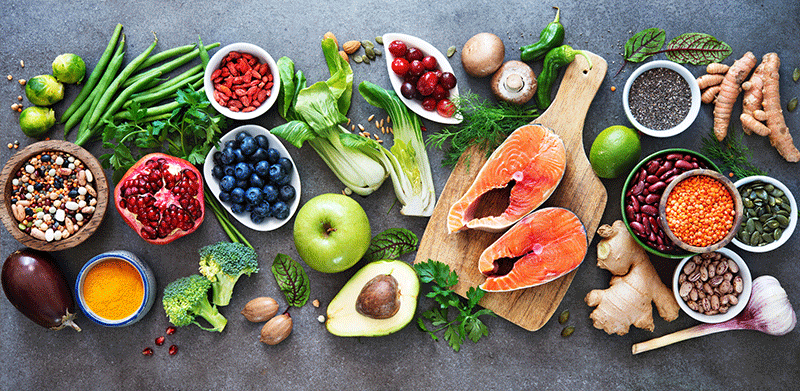5 Superfoods for a Nutrient-Rich Diet Boosting Your Health From Within

Superfoods are nutrient-dense foods that provide high amounts of vitamins, minerals and antioxidants. While there is no standard definition for what qualifies as a superfood, some common examples include kale, salmon, berries and kefir.
You can incorporate these health-boosting foods into your diet by making simple swaps. For example, swap guacamole for avocado on your next salad or try a smashed berry and avocado smoothie.
Acai Berries
Everyone knows that eating multiple servings of fruits each day is an important part of a healthy diet. However, not all fruit is the same. Each one contains distinctive vitamins, minerals and chemical compounds that work together to support your health in different ways.
Acai berries are rich in antioxidants, which help combat free radicals that cause oxidative stress and can lead to a variety of chronic diseases. They are also high in fiber and healthy fats, including Omega 3, 6, and 9 fatty acids.
These little berries are also packed with amino acids, which are absorbed quickly by the body to promote muscle growth and boost energy levels. They are the perfect snack for post-workout recovery.
Blueberries
Berry fruits—like blueberries, blackberries, strawberries, cranberries, bilberries and raspberries—provide potassium, vitamin C, folate, pantothenic acid, manganese, fiber and anthocyanins. They also contain quercetin and myricetin, two flavonoids that help lower your risk for heart disease (1, 2).
The anthocyanins in blueberries combat oxidative stress and inflammation, which are factors for chronic illness, according to research published in 2021 in the journal Frontiers in Nutrition. These little bite-size berries also boost insulin sensitivity, guard against macular degeneration and help improve brain function, per a 2019 review in the journal Molecular Neurobiology. Plus, they supply 3.6 grams of fiber per cup, which helps support bowel regularity and prevent constipation.
Cinnamon
A staple of the Mediterranean Diet, cinnamon is known for reducing inflammation, blood sugar and cholesterol levels. It also has prebiotic properties that can promote gut health.
Cinnamaldehyde and cinnamic acid are bioactive compounds found in cinnamon that prevent oxidation of fat cells. This reduces LDL (bad) cholesterol and triglycerides and helps control blood pressure.
One study found that an aqueous extract of cinnamon bark significantly inhibited tau aggregation and filament formation, two features of Alzheimer’s disease [101]. Add some spice to oatmeal, coffee or smoothies. It’s also a great topping for baked apples or pumpkin-apple chia muffins. Store spices in a cool, dark place.
Leafy Greens
Many people think of salad when they hear the word leafy greens, but these healthy foods are much more than just a standard lettuce and veggie dish. Leafy greens are nutritional powerhouses that help reduce risk for health conditions like stroke, anemia, high blood pressure and cancer, while boosting immunity, heart, bone and eye health.
Some examples of leafy greens include kale, spinach, broccoli sprouts, bok choy and watercress. You can add them to salads, fold into an omelet, steam or roast them and even use them to make delicious chips! Plus, they’re low in calories and provide vitamin A, C, K, and folate, as well as potassium, calcium, iron and magnesium.
Kale
Whether you eat it raw or cooked, this leafy green superfood has tons of benefits. It’s low in calories and contains many nutrients such as vitamins K, A, and C, minerals like calcium, potassium, magnesium and iron, and antioxidants.
FRN lead dietitian Nichole Dandrea-Russert, MS, RDN, loves to massage 2-3 cups of kale leaves (reserving the stems for another meal) with lemon and olive oil. She adds other veggies and some protein for a complete meal.
A cup of kale provides vitamin K, a good source of lutein and zeaxanthin (which can reduce age-related macular degeneration), and some vitamin A (good for eye health). It’s also high in potassium, which is needed to make the blood able to carry oxygen.
Swiss Chard
Swiss Chard is a green leafy vegetable rich in fiber, vitamins, minerals and antioxidants that your body needs. It can be eaten raw or added to stews, soups, salads, stir-fries, frittatas and pastas. It may help reduce the risk of some chronic diseases, promote weight loss and maintain healthy blood sugar levels.
It is rich in vitamin K that is required for proper blood clotting and various cellular functions. It is also a good source of vitamin C and contains magnesium, manganese, phosphorus and potassium.
It is also rich in carotenoids lutein and zeaxanthin that protect against eye disorders like macular degeneration and glaucoma. It also has a range of phenolic compounds and flavonoids that fight free radical damage and inflammation.